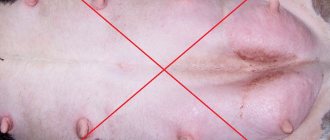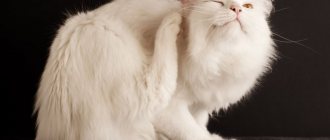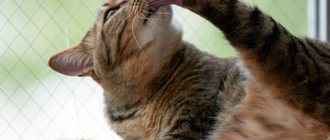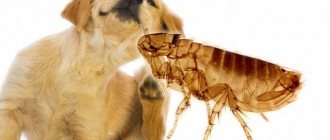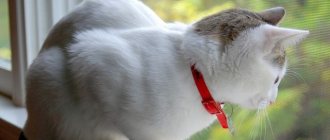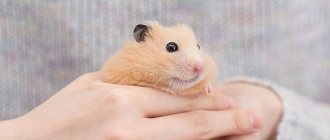7353Administration
In order to remove fleas from a kitten correctly, it is recommended to use comprehensive methods of parasite control. The reason for their appearance may be communication with an adult cat, and in its absence, the first forays into the street. The little fidget continually strives to explore this huge world and sometimes finds itself in unpleasant situations. The owner has to correct the animal’s mistakes and do everything to get rid of fleas. Therefore, finding a remedy for parasites becomes a priority during the development of a kitten.
Signs of parasitism by blood-sucking insects
Fleas can appear on both an adult and a newborn kitten. If the cat did not undergo the necessary treatment at the time and gave birth to a kitten, then it becomes infected after birth.
The main sign of parasitism is itching. Along with this, worms, an allergic reaction and even dermatitis may appear. Insects are more dangerous for a baby than for a mature cat. Among the consequences of infection, it is worth highlighting - loss of appetite and exhaustion, anemia.
Parasites can be transferred to humans and cause harm to them as well. From a flea bite, people experience similar symptoms - itching and allergies, swelling of the skin and redness.
Signs of infection in kittens:
- dermatitis;
- loss of appetite and weight;
- hair loss;
- scratches and scratches;
- anxiety.
The kitten is constantly itching, scratching the skin and leaving damage on it. If you part the fur, you can find insects. They can be visually identified by small black dots that actively move. Drops of dried blood and possible feces remain on the skin. Fleas lay eggs on the animal's body. They can be identified - these are light grains that look like salt.
The location of the parasites is the neck, tail and lower back. A pet can become infected at any time and not from a cat. The pet becomes infected:
- on the street while walking;
- from people who may bring home parasites on shoes or clothes;
- from other pets in the house.
If a kitten shows signs of infection, it is worth examining its body, and if an infection is detected, take immediate measures to remove fleas. If the only visible cause is itching, and there are no fleas on the body, then it is worth contacting a medical institution to check the patient for other diseases.
Various medications are available on the veterinary market to treat and get rid of fleas. Removing fleas from a small kitten is quite difficult. Buying cheap medications or the first ones you come across will have a negative impact on your health.
The best and most effective flea treatments for cats
Sprays
Kitten skin spray can also be used as flea treatment. The preparations are quite easy to use and are easily applied to the surface of the kitten’s skin. It is enough to part the fur and sprinkle the cat’s undercoat, especially carefully treating the most problematic areas - behind the ears, tummy. At the same time, you should not let the kitten lick already treated areas, so that the baby does not get poisoned.
Treatment with a spray gives instant results - fleas are eliminated instantly, they die directly from the action of the spray. After some time, the baby needs to be bought to wash off the dead arthropods from the fur. After drying the kitten, the undercoat is checked to ensure that there are no living fleas left.
In almost one hundred percent of cases this does not happen, for which the sprays have deservedly received the most positive reviews from kitten owners. A significant disadvantage is the toxicity of the spray, so it is necessary to strictly observe the age at which treatment is permitted and the dose of the drug applied to the surface of the skin. Most sprays are intended for use in animals from two months of age.
IMPORTANT! Frontline is considered the most proven product - the line of this group of products also includes a spray for treating kitten fur.
According to the manufacturer's recommendations, the product can be used in small kittens, and it does not harm the baby. It should be borne in mind that a drug that kills fleas within a day cannot be completely harmless, therefore it is not recommended for them to remove fleas from newborn kittens.
In addition to Frontline aerosol, there are other means that help cope with blood-sucking arthropods in kittens. These are, first of all, Harts, Bars, Bolfo-Aerosol. The effectiveness of these products varies, but mainly the drugs help get rid of fleas; in rare cases, repeated treatment may be necessary.
What products are used to control fleas in kittens?
You can get rid of fleas on a kitten using different drugs, but they all put a strain on the body. Newborn animals are sensitive to all drugs and infections. Therefore, many medications are simply not suitable for them, since they contain chemicals that are prohibited for use for up to a year.
It is worth understanding that you cannot hesitate here; you need to use a flea remedy suitable for newborn kittens. Fleas cause anemia, which leads to the death of all offspring. Effective methods of control involve a one-time application of the drug. And then you should use a medicine with a prolonged action. Only insecticides have this property. Traditional recipes can be used daily for several months.
Manual comb treatment
Removing fleas from a 2-month-old kitten is also possible using manual treatment with a comb. In the first months, pets are very weakened - their body may not withstand chemical treatment with harsh compounds. And brushing with a fine comb is suitable even for newborn kittens.
The owner must have the skill to give a healthy life to the kittens. Combing is carried out in the direction of the fur. It is recommended to throw all fleas into a bowl of water and crush them. Particular attention should be paid to the groin area and armpits, as parasites accumulate there.
This method is useful at any age of the kitten. If a mother cat is present nearby, she can bite off fleas and lick the kitten herself. After gaining independence, it is possible to switch to medical aids.
Shampoos
Brushing is not an effective method of treating an infected kitten that has been weaned from its mother. It cannot yet defend itself, so its owner needs to fight.
If the patient is more than a month old, then experts recommend using a specialized shampoo. This is an effective method in the fight against parasites. Some brands are intended for kittens as young as 2 weeks.
There are few active chemicals in the detergent. But when bathing for the first time, you should add less product than indicated on the package to avoid allergic reactions. Thus, it is possible to rid a kitten of fleas on your own at home without the use of chemicals.
Drops
You can also rid your kitten of fleas at home using insecticides. There are drops on the market for kittens of different ages. The product must be applied strictly according to the instructions. This is due to the fact that insecticides have:
- Low to moderate toxicity, so precautions must be taken when using.
- Apply the product only to dry skin.
- If there is scratching, drops should not be applied.
- Drops should be applied from the back of the head to the shoulder blades (about 2-3 places).
- Do not allow the cat to lick itself until the chemical has completely dried (depending on the brand, 2-24 hours).
Allergic reactions may occur in the form of:
- Redness at the site of application of the drops, itching and burning.
- The appearance of an unhealthy shine in the eyes.
- Increased body temperature in a kitten.
- Lethargy.
- Apathy.
- Gag reflex.
- Dilated pupils and convulsive syndrome.
15 most effective flea drops for cats
In these cases, you must contact medical staff.
Sprays
Understanding a kitten is a difficult task for the owner, but it is necessary to determine whether the pet is infected. After 2-3 months, insects can be removed using a spray. This must be done by spraying a chemical throughout the body, including the tail and head.
A small kitten will want to lick the fur, but the breeder must prevent him from this desire, because... Poisoning may occur and re-treatment will be required. The spray is absorbed within 15 minutes. If a 2-month-old kitten has long hair, then the medicine may not be effective. The composition should not remain on the fur, but should be absorbed into the skin.
When used correctly, the effect of the drug is six months. The dosage is specified on the packaging, depending on the weight and breed of the animal.
Collar
Washing an animal with shampoo and poisoning insects with chemicals is a burden on the emotional state and health of the pet. Many breeders choose collars as a safety measure.
This method is not a fight against the disease that has arisen, but protection against it. The product is used for older kittens whose age exceeds 3 months. Used periodically during self-walking or in the country.
Attention! You should not think that there are no insects in the apartment - they move from the street on clothes. Therefore, it is worth using a combined method of protection - a collar and the chemical described earlier. For example, tar shampoo.
Which drops to choose?
The choice of drops due to the wide range is not easy, we will focus on the most popular:
- Advantage guarantees protection not only for the cat, but also for her kittens. Low toxicity, fast acting and can be used to prevent future infections. The price of one pipette is 215 rubles. Reviews for the product are good: “Not the cheapest, but effective”, “unique drug”, “cool medicine”.
- “Bars”, a domestic manufacturer, offers 4 types of parasite repellents: Spot-on complex product for cats and dogs; for kittens; for adult cats against fleas; from ticks and fleas. The owners gratefully turn to the creators of the product: “it helped the first time,” “does not cause negative consequences,” “I recommend Bars Forte.” The price of the product is 275 rubles for 3 pipettes of 1 ml, the duration of protection is up to 30 days. The manufacturer of the drug, Hartz , claims that fleas will die after the first application, it is applied along the spine and is often recommended by specialists in different countries. Not recommended for treating kittens under 3 months of age. From the reviews they note a good effect, a “counterattack on fleas”, recommendations from a veterinarian.
- Inspector drops are not the cheapest, but the effect will not be long in coming (the manufacturer promises to deal with bloodsuckers within 2 hours). It is used not only to combat fleas, but also 12 other types of various parasites. Prohibited for use on pregnant and lactating cats, animals weighing less than 1 kg.
- For external treatment, “celandine” - drops against fleas; the kitten is strictly forbidden to lick them off. The product is not absorbed into the blood and accumulates in the epidermis; parasites immediately die upon contact with it. Can be applied to kittens over 2 months of age. They offer to buy the domestic product at a price of 130 rubles per package, designed for several uses.
Natural formulations are preferable if treatment with traditional preparations cannot occur for some reason. You can remove fleas with apple cider vinegar, a decoction of pine needles, wormwood, eucalyptus, tansy (you can place plant branches in the kitten’s habitat). Parasites cannot tolerate citrus aroma.
Drops are used as a preventative measure several times a year. Full compliance with the recommendations and instructions guarantees results without causing harm to the health of the pet.
What to choose depending on the baby’s age
Treatment is carried out according to the age of the kitten. A newborn is more gentle to chemicals than a six-month-old baby. Therefore, experts always prescribe the dosage for a specific age on the packaging.
1 month
Age requires additional protection. Especially if the kitten was separated from its mother. Scratching is suitable for a newborn, and can also be washed with a gentle product. It is better to choose a natural shampoo that will help protect the kitten from insects and minimize the onslaught of fleas.
1.5 months
At this age, you can use all the methods as for a newborn. Additionally, there are sprays on the market that can be applied from 1.5 months of age.
They can only be purchased at a veterinary clinic. The hardware department of some shopping centers also offers a wide selection of flea baiting chemicals.
2 months
An infectious kitten at 2 months can already use specialized drops in addition to sprays, shampoo and combing. They can be purchased at veterinary pharmacies without a prescription.
Important! You should not wash your kitten for 4-5 months after applying the product. If this cannot be avoided, the drops are reapplied. The drops must be used strictly according to the instructions.
3 months
At 3 months, you can use all the means discussed earlier - shampoos, sprays and drops, combing (although kittens at this age can already do this on their own).
Important! Only a veterinarian or a breeder at his own discretion can determine which method is best to use. The main thing is to choose a drug based on age and weight.
Shampoos
Flea shampoos are the most popular means of removing parasites from a kitten’s skin and can be used from two weeks of age. The popularity of shampoos is due, first of all, to the fact that they are inexpensive, help well, and the owners still prefer to wet treat the baby’s fur, especially if the kitten was brought in from the street. A significant difficulty can be the fact that not all kittens like to bathe, and even more so with the use of detergents.
If treated well, the kitten will not be afraid of water.
If, nevertheless, shampoo has become the means of choice for getting rid of fleas, you must act as carefully as possible. The detergent is applied to the animal's ears, head, neck and the rest of the body. The most important thing is to treat the tummy, where fleas gather in large numbers. When washing their hair, water should not get into their ears - in any draft, small kittens can become victims of otitis media.
For small kittens at 2 weeks, the procedure is faster and more loyal. Separately, dilute a teaspoon of shampoo in 500 ml of water and whip up foam. The baby is dipped in water several times and kept in the bath for 5 minutes for the solution to take effect. The product is quickly washed off with clean water and the kitten is dried.
It is best to carry out the washing procedure quickly so as not to cause trouble for the kitten. Helpers in this regard will be Demos-Lux, Bars, Insectin, Fitoelita and other names of drugs. If it is necessary to remove fleas from a small kitten, you need to get rid of parasites using the most animal-tolerant means possible. Shampoo Mr. received good reviews. Kiss is one of the most harmless shampoos produced by a Swiss company. The shampoo can be used in kittens from one month of age.
Rules for bathing kittens
It is worth remembering that not all drugs are approved for use. Initially, the shampoo is diluted with water, and the pet’s fur is lathered with this solution. The pet should remain in this state for several minutes (see instructions). After the time has passed, the kitten should be washed with warm, but not hot water and dried. At the end of the procedure, the pet should be combed with a fine comb, which will help to finally get rid of the insects.
Choosing a specialized shampoo
When choosing a shampoo, you should consider the following characteristics of a kitten:
- Age of the kitten. Newborns are recommended a specialized product that will not damage their skin.
- The intended purpose is that if the infection is severe, then insecticides are used, and the preventive measure implies a gentle composition.
- Depending on the pet's condition - with a weakened body, anemia, pregnancy, only a gentle composition.
- Features of wool - shampoos for both long-haired and sphinxes.
- Storage period.
To correctly resolve issues related to the health of your pets, we recommend contacting a veterinary clinic.
Let's name the main brands of shampoos:
- Leopard. Used for newborns as a prophylaxis.
- BioVax. Used as a preventive measure for babies from 1 month of age. Also suitable for sick and weakened animals.
- Celandine. Used as treatment and prevention from the age of two months.
- Lugovoy. Used as treatment and prevention from 12 weeks of age.
The remaining shampoos are used for kittens from 4 months of age.
We create conditions so that the kitten does not get sick
To avoid infection, the breeder has the right to take preventive measures. Basic tips:
- daily examination of your pet for the presence of parasites;
- use of insecticides;
- frequency in the house;
- limited contact with non-domestic pets.
If it was not possible to avoid infection, then drastic measures must be taken to ensure a speedy recovery of the pet.
Soaping the composition
Soaping the composition is a complex process and you can’t do it without an assistant. Cats rarely like to take baths, so you need to hold your pet and thoroughly rub in the shampoo, avoiding the area around the eyes and face.
Carefully distribute the required dose over the entire body, including the abdomen, allow it to be absorbed, and then rinse off. Under no circumstances should you allow your cat to lick you for 10 minutes.
To avoid getting the product into your ears, you must first plug them with cotton tubes, which should be moistened with vegetable oil. It is necessary to rinse the kitten's fur thoroughly so that no chemicals remain.
How to dry your pet's fur
Drying a kitten after taking a bath is an important operation that preserves its health, because the body of babies is not protected from the effects of the sun and cold, as well as drafts. One drying method is to use a hair dryer. But you need to do this wisely. You can’t point it at the muzzle; you need to turn on the medium mode.
If the cat is afraid of the sound made, then you need to purchase a quieter device or use a heater-wind blower. The cats always move closer to him and are not afraid of him.
After taking a bath you should not:
- Remove the towel and immediately allow the cat to dry itself.
- Lock the animal in a cold room with an open window.
- Screaming while bathing and drying.
- Keep in a wet towel for a long time.
- Leaving the cat wet.
After blow-drying, comb the kitten and then reward it with a treat.
What to do if a kitten is poisoned by a drug
First provide first aid. Then go to the veterinary clinic and explain everything to the staff. Unlike an adult, a kitten’s infection develops quickly and the consequences can be more serious.
Regardless of what poisoned the kitten, you need to provide first aid. To reduce the concentration of the substance that caused the poisoning, it is worth giving the kitten water. If he refuses water, you need to pour it through a pipette.
If the substance gets through the fur, immediately bathe the pet. In case of chemicals that have got inside, you need to give 2 tablets of activated carbon and take the kitten to a veterinary clinic. Explain the cause of poisoning to provide effective assistance to your pet.

